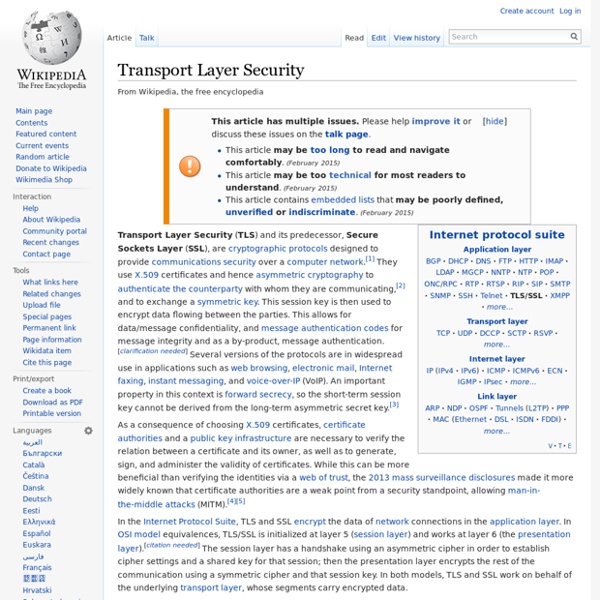Transport Layer Security

Transport Layer Protection Cheat Sheet
Last revision (mm/dd/yy): 09/29/2018 This cheat sheet provides a simple model to follow when implementing transport layer protection for an application. Although the concept of SSL is known to many, the actual details and security specific decisions of implementation are often poorly understood and frequently result in insecure deployments. This article establishes clear rules which provide guidance on securely designing and configuring transport layer security for an application. This article is focused on the use of SSL/TLS between a web application and a web browser, but we also encourage the use of SSL/TLS or other network encryption technologies, such as VPN, on back end and other non-browser based connections. Architectural Decision An architectural decision must be made to determine the appropriate method to protect data when it is being transmitted. TLS is mainly a defence against man-in-the-middle attacks. Benefits Basic Requirements SSL vs. Cryptomodule Parts and Operation 1. 2.
10 Immutable Laws of Security Administration
By Scott Culp November 2000 We recently published the 10 Immutable Laws of Security, a listing of ten facts of life regarding computer security. As in the case of the immutable laws for users, the laws on this list reflect the basic nature of security, rather than any product-specific issue. On This Page Law #1: Nobody believes anything bad can happen to them, until it does Many people are unwilling partners in computer security. As a result, relying on voluntary measures to keep your network secure is likely to be a non-starter. Law #2: Security only works if the secure way also happens to be the easy way As we discussed in Law #1, you need the authority to mandate security on the network. There are three key things you can do to prevent your users from becoming hackers' unwitting accomplices. Make sure your company's security policy is reasonable, and strikes a balance between security and productivity. Law #3: If you don't keep up with security fixes, your network won't be yours for long
Networking 101: Transport Layer Security (TLS) - High Performance Browser Networking (O'Reilly)
Introduction The SSL protocol was originally developed at Netscape to enable ecommerce transaction security on the Web, which required encryption to protect customers’ personal data, as well as authentication and integrity guarantees to ensure a safe transaction. To achieve this, the SSL protocol was implemented at the application layer, directly on top of TCP (Figure 4-1), enabling protocols above it (HTTP, email, instant messaging, and many others) to operate unchanged while providing communication security when communicating across the network. When SSL is used correctly, a third-party observer can only infer the connection endpoints, type of encryption, as well as the frequency and an approximate amount of data sent, but cannot read or modify any of the actual data. When the SSL protocol was standardized by the IETF, it was renamed to Transport Layer Security (TLS). TLS was designed to operate on top of a reliable transport protocol such as TCP. Encryption Authentication Integrity 0 ms
Related:
Related:



